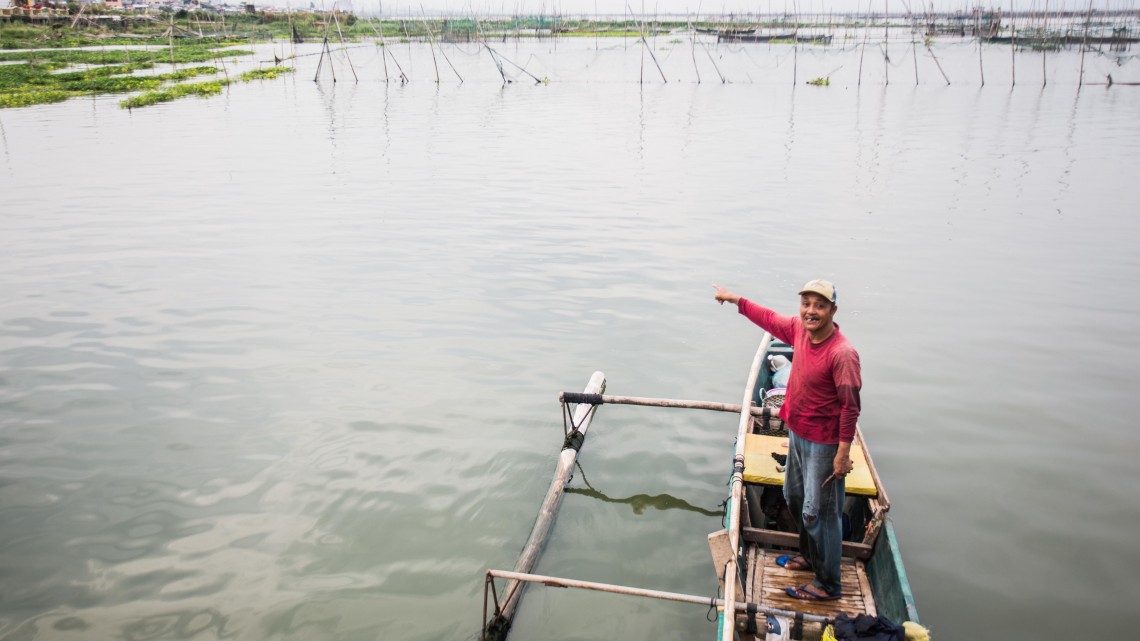photo courtesy of Tudla Productions, 2016
IBON International Feature Series #2
[[{“type”:”media”,”view_mode”:”media_large”,”fid”:”1576″,”attributes”:{“alt”:””,”class”:”media-image”,”height”:”270″,”style”:”width: 350px; height: 197px; margin: 10px; float: right;”,”typeof”:”foaf:Image”,”width”:”480″}}]]
Since the 2001 launch of its public-private partnership (PPP) program, the United States Agency for International Development (USAID) has initiated 1,600 so-called “development PPPs” around the world.[1] USAID is also a strong promoter of “infrastructure PPPs” by means of technical assistance. Its promotional efforts have been particularly strong in the Philippines. The case of the Laguna-Lakeshore Expressway-Dike (LLED) project stands out both as an example of USAID’s influence (discussed in our previous article: How USAID influences PH national policy: Technical aid to advance US interests) and as a cautionary tale illustrating some of the serious problems that can arise in PPP projects.
According to the USAID COMPETE year-two report, “The LLED Project was not on the original list of the government’s PPP projects [. . .]. But now, it is No. 1 on the list and the biggest PPP project to date.”[2]
The USAID COMPETE report describes the LLED project as follows:
LLED has two components: (a) a 6-lane expressway-dike; and (b) land reclamation. The project aims to mitigate flooding in the Laguna Lake coastal towns, particularly in Southern Metro Manila and Laguna, improve the environmental condition of the Lake, and promote economic activities through the efficient transport of goods and people. LLED involves the construction of a 47-kilometer flood control dike on top of which will be a high-speed tollway. The project will likewise provide opportunities for developing a new business and residential district (Central Business District) in the reclaimed areas.
As in many official descriptions of the project, the aims of mitigating flooding, improving environmental conditions and promoting economic activity are placed side-by-side. While it would be ideal for this to be the case, such a comprehensive approach would require giving equal attention to each element, something that has not occurred in the LLED planning stage. Instead, the attention has narrowed to the more profitable aspects, heightening the risks posed by unforeseen complications, which could jeopardize the project and endanger the community surrounding the project site.
Besides being the Philippines’ biggest, the project has also become perhaps its most complicated, both technically and politically. In fact the project has been considered by bidders to be “unviable.” The government consequently is under pressure to repackage the project to find ways to increase its profitability, something that has happened before with other PPPs failing to secure bids. This is a questionable approach given the government’s duty to the public interest.
It is difficult to imagine how the LLED project, with its potentially catastrophic social costs, might be attractively repackaged in the context of public opposition. This opposition to the project focuses on both the large-scale resident displacement that would result and the serious disaster-related risks in its current design that would threaten the proposed infrastructure, not to mention the endangerment of its future inhabitants, utilizers and maintainers. Given all the technical assistance provided by USAID, it would be disingenuous to suggest that the social costs were undetected by USAID or the government. A more truthful assessment would be that many of these social costs simply were not considered to be real costs, due to overriding private interests in the project.
A Laguna Lake Authority (LLA) document entitled “Laguna de Bay Basin by 2020” reported that the project would require the eviction of 6,800 families in barangay Malabanan in Biñan, 4,800 families in Sinalhan in Santa Rosa, at least 60,000 families in “LupangArenda” in barangay San Juan in Taytay, Rizal. Another 10,440 families in the informal settlements situated along the shoreline would also be displaced. The total “relocation cost” has been calculated to be ₱200,000 (US$4,000) per household, bringing the total eviction costs to approximately ₱6.5 billion (US$144 million) for 80,000 households.[3]
In this accounting for the displacement, however, significant costs are not included, particularly the social costs of the undemocratic procedures by which eviction is often implemented. For example, according to the Asian Human Rights Commission, in eviction and demolition efforts that took place in Taguig in March of 2015, a 300-member team jointly consisting of the Philippine National Police (PNP) and the Public Order and Safety Office (POSO) “confiscated whatever little personal belongings the household[s] had like kitchen utensils, blankets, papaya trees, wood, lumber, and padlocks.”[4]
There is a tendency to consider these procedures distinct from the PPP project itself, as incidental occurrences during the implementation. However, the institutional context is a critical part of any assessment and should be identified as a constitutive social cost inherent to PPPs.
In the Philippines, a crucial institutional contextual issue for PPPs is the PPP Act, particularly its alternative dispute resolution (ADR) system, which places constraints on the legal options available to those who contest either the project itself or the state-initiated procedures accompanying it. For example, these constraints include the prohibition on the issuance of Temporary Restraining Orders (TROs) against PPPs by local courts. Given that TROs have been issued by the Supreme Court against actions of PPP project concessionaires (e.g., those of the MRT and LRT), the prohibition of similar recourse in local courts in cases of legitimate risk to communities constitutes a significant loss of the democratic space. Therefore, while confiscation and displacement may not appear necessarily linked to PPPs,[5] the legislative context that determines the rights of those implementing PPP contracts (and the relative lack of rights of community members) are enabling factors that permit injustices for affected populations.
In addition to mass displacement, reasons that might justify the issuance of a TRO in relation to the LLED project have been identified by a coalition of at least five Catholic dioceses. They have “vowed to support other faith-based groups and people’s organizations in opposing the project.”[6] Concerns relate to unaddressed safety and environmental hazards, ones that find support in studies by, and consultations with, geologist Kelvin S. Rodolfo. Put concisely, “[i]f the project is constructed and protects Metro Manila from lake-water floods, people living elsewhere along the lake will suffer, simply because the flood water will have to go somewhere.”[7] The greatest threat, according to Rodolfo, is an earthquake. Because of the proximity of the LLED project site areas to fault lines, an earthquake is a likely event. He writes:
Reclamation areas [. . .] closer to the fault zone are underlain by thick, water-saturated sediments. Any structures built there would experience catastrophic damage during a major WMV Fault earthquake. They would shake more strongly from the earthquake waves than structures sitting on solid rock. [. . .] While the earthquake lasts, its shaking would also transform the sediment and its water content into a liquid-like mixture without strength. Buildings would sink into it or topple.[8]
In his article in Philippine Science Letters, “On the geological hazards that threaten existing and proposed reclamations of Manila Bay,” Rodolfo debunks several misleading assertions by government officials in an attempt to promote the project, which reference “successful” reclamation projects in the past. Rodolfo explains,
The Department of Public Works and Highways has long ignored or minimized the problem of land subsidence in planning their expensive but ineffective flood-control projects[9][. . .]. It would not be surprising if reclamation planners also ignore subsidence to minimize costs and maximize profits, but thereby enhance risks.[10]
Given that much of the former Aquino administration’s reform efforts, as well as a significant focus for USAID technical assistance, related to the promotion of good governance in order to, among other things, better facilitate infrastructure projects, it is telling that DPWH lapses indicated by Rodolfo were allowed to persist. The issues ignored by DPWH are some of those with the greatest relevance for infrastructure provision. It might be interpreted as a case of technical assistance being freely offered by Rodolfo, a scientist with little apparent political motivation, only to be ignored by government officials in favor of USAID prescriptions, which are far from approaching Rodolfo’s level of impartiality. Whatever these officials’ motivations, the effect is an institutionalization of “good governance” practices that are proving to be very hostile to ordinary people.
*Portions of this article have been originally published in the Reality of Aid 2016 Report on Technical Cooperation as an Aid Modality.
[1] George M. Ingram, Anne E. Johnson and Helen Moser (2016), “USAID’s Public-Private Partnerships: A Data Picture and Review of Business Engagement” (Washington, DC: Brookings Institute), p. 30. http://www.brookings.edu/~/media/research/files/papers/2016/02/usaid-public-private-partnerships-ingram-johnson-moser/wp94pppreport2016web.pdf, accessed 5 Jun. 2016.
[2] USAID (2014), Advancing Philippine Competitiveness (COMPETE) Project: Year 2 Annual Report (Washington, DC: USAID), pp. 5‒6 http://pdf.usaid.gov/pdf_docs/PA00KF99.pdf, accessed 16 Jun. 2016.
[3] Dennis Espada (2014), “Residents spur resistance to road dike, reclamation plans,” Bulatlat, 7 Nov., http://bulatlat.com/main/2014/11/07/residents-spur-resistance-to-road-dike-reclamation-plans/, accessed 28 Jun. 2016.
[4] Asian Human Rights Commission (2015), “PHILIPPINES: Stop demolition against Laguna Lakeshore community in Taguig,” 8 May, Hunger Alerts, http://www.humanrights.asia/news/hunger-alerts/AHRC-HAU-002-2015, accessed 29 Jun. 2016.
[5] In fact, displacements have been reported to accompany PPPs in numerous cases. The LRT Line 1 Cavite extension, for example, is also expected to entail displacement of many informal settlers.
[6] Evelyn Macairan (2016), “Church to campaign vs Laguna Lakeshore,” The Philippine Star, 31 Mar., http://beta.philstar.com/nation/2016/03/31/1568046/church-campaign-vs-laguna-lakeshore, accessed 5 Jun. 2016.
[7] Kelvin S. Rodolfo (2016), “The dangerous Laguna Lakeshore Expressway Dike,” Rappler, 24 Jan., http://www.rappler.com/science-nature/ideas/120068-dangerous-laguna-lakeshore-expressway-dike, accessed 5 Jul. 2016.
[8] Ibid.
[9] Kelvin S. Rodolfo and Fernando P. Siringan (2006), “Global sea-level rise is recognised, but flooding from anthropogenic land subsidence is ignored around northern Manila Bay, Philippines,” Disasters (Oxford, UK: Blackwell Publishing), Vol. 30, No. 1, pp. 118‒139, http://www.paase.org/images/Rodolfo-Siringan2006.pdf, accessed 29 Jun. 2016.
[10] Kelvin S. Rodolfo (2014), “One the geological hazards that threaten existing and proposed reclamations of Manila Bay,” Philippine Science Letters, Vol. 7, No. 1, http://philsciletters.org/2014/PSL%202014-vol07-no01-p228-240%20Rodolfo.pdf, accessed 29 Jun. 2016.

![[WEBINAR] On the Human Rights Situation in the Philippines: Lessons from the 4th Cycle of the Universal Periodic Review](https://iboninternational.org/wp-content/uploads/2023/02/327873979_5917321721660855_5378398432499176061_n-300x200.jpg)

